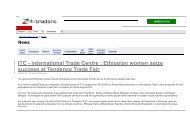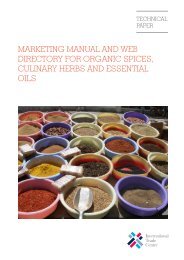Gender Mainstreaming: The Role Entrepreneurs Can Play and Why ...
Gender Mainstreaming: The Role Entrepreneurs Can Play and Why ...
Gender Mainstreaming: The Role Entrepreneurs Can Play and Why ...
Create successful ePaper yourself
Turn your PDF publications into a flip-book with our unique Google optimized e-Paper software.
INTERNATIONAL TRADE CENTRE UNCTAD/WTO Page 3<br />
market’ <strong>and</strong> this can be through chambers, conferences, trade missions, trade associations<br />
<strong>and</strong> businesses that have traditionally been more open to men.<br />
Large companies have a role to play in opening opportunities for women entrepreneurs as<br />
well. Women entrepreneurs are not only suppliers of goods <strong>and</strong> services, but we are also<br />
users of goods <strong>and</strong> services. We purchase raw materials, we bank at financial institutions,<br />
we use telephones, computers, couriers, office supplies, professional advisers – all the<br />
goods <strong>and</strong> services that any business uses. Individually our businesses may be small at<br />
the moment, but collectively we represent a very large <strong>and</strong> growing market.<br />
Who to ‘target’ – Spheres of Influence, Decision Makers, Potential<br />
Champions<br />
Look around to see who the leaders are: who do you want to target? Everyone knows<br />
who they are: the spheres of influence, the decision makers, the networks, but most of all,<br />
who can you enlist to be ‘champions’ for women entrepreneurs. Champions are found<br />
when you least expect it: other successful women, politicians, civil servants, high profile<br />
men, business people <strong>and</strong> they exist in the:<br />
v Public sector<br />
v Private sector<br />
v Associations <strong>and</strong> networks<br />
How To Do It – Get Involved<br />
<strong>Gender</strong> mainstreaming in the context of businesswomen is all about inclusion <strong>and</strong><br />
recognition. <strong>The</strong> best way to achieve this is to just get involved. <strong>The</strong> following are some<br />
general guidelines that are helpful:<br />
‣ Identify issues <strong>and</strong> why - what is it that you want to be included in <strong>and</strong> why<br />
aren’t women included? Often this is for economic reasons – if so, look for<br />
alternative. For example if it is too costly for women to join chambers or<br />
organizations then look for alternatives such as a woman representative or<br />
having an associate relationship through another organization such as a<br />
women’s organizations. If the conferences are too expensive to attend, then<br />
nominate women as speakers or even volunteers to assist in organizing,<br />
providing services or participation in promotion – the key is to get included <strong>and</strong><br />
get in the door;<br />
‣ Define desired outcomes – before you start, determine what is your desired<br />
outcome – is it women on trade missions, more women members, more women<br />
speakers, better policy for women, - determine the desired outcomes <strong>and</strong> be<br />
strategic in achieving them;<br />
‣ Show how the objectives will provide benefits for women – often the benefits to<br />
women are not instant or obvious so show how women can benefit from a more<br />
inclusive business community;<br />
‣ Show how the participation of women can be sought – as in the model illustrated<br />
below, it may be necessary to actually show how women can be identified <strong>and</strong><br />
solicited – when women are not part of the formal sector or business community,<br />
it is too easy to assume that they do not exist, or are not interested - therefore<br />
women have to be active in identifying each other;
















